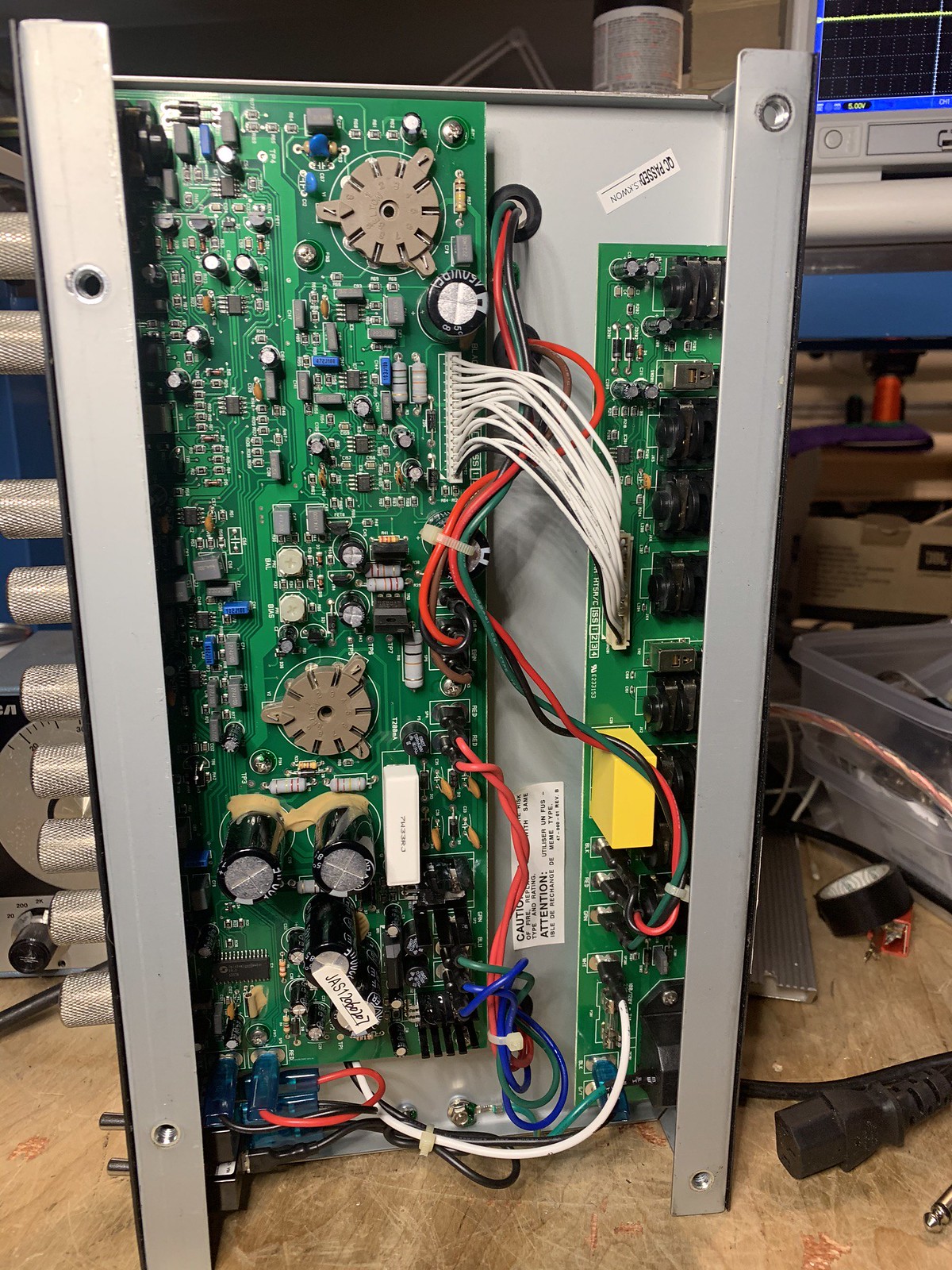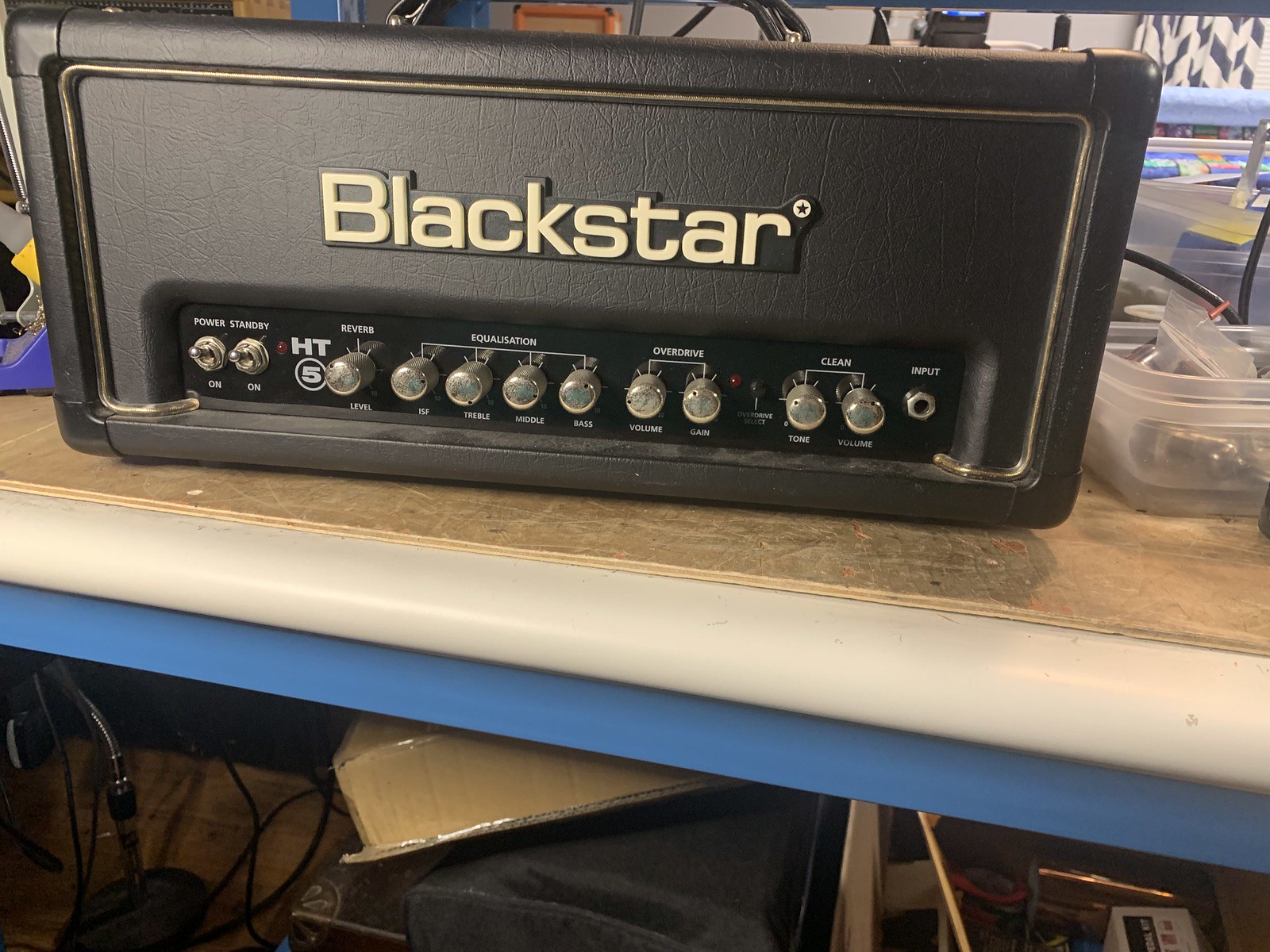CapnDenny1
Student Of The Blues
The next in the line of amps from the bonepile, a cute little Blackstar HT5RH head amp. 5 watts of tube power! A single 12ax7 preamp tune and a 12BH7 power amp tube. The 12BH7 is the same pinout as the 12ax7, with 2 separate tube amps inside the glass. They use both sides in the 12BH7 to do a regular class AB push-pull power amp.
It's an interesting little big amp. The cab weighs a ton. I have had combo amps that were lighter. Built like a brick schmidthouse. I bought it off ebay too long ago to go back and read what was wrong. But it had the tubes and knobs which is always nice. It basically had no sound. It wasn't blowing fuses or drawing too much power, but no output.
I tried hooking into the Send/Return input, and that seemed to be dead as well. So I went about looking for a schematic. It is so much easier with a schematic. Blackstar won't share them, but somebody else did. There are apparently several versions of the HT5, and the one I have with the reverb is somewhat newer. Here's a few pics of the guts of the amp. The amp is pretty complicated, with a lot of circuits fro such a simple seeming amp.
 3FAE323E-3549-4468-8EF6-0CF4DC03539F by Dennis Kelley, on Flickr
3FAE323E-3549-4468-8EF6-0CF4DC03539F by Dennis Kelley, on Flickr
I traced the signal from the signal generator through the preamp all the way to pin 1 (black wire) of the 14 pin bunch of mostly white wires going from the main pcb to the back panel pcb. The black wire is the send and the next one, pin 2, is the return. It was making it there, but not coming back on pin 2 to get to the power amp.
I followed it to the return jack, which has the usual shorting switch, if no plug is inserted it shorts the Send right back to the Return. The Return jack is the second from the top.
 DD455DAA-B81A-47FF-8A96-CBFC3AF7854C by Dennis Kelley, on Flickr
DD455DAA-B81A-47FF-8A96-CBFC3AF7854C by Dennis Kelley, on Flickr
When I probed this with my ohmmeter it read as zero ohms, but if I probed on the pcb it was open. I tried cleaning it and that made no difference. If I had one of these on hand I would have replaced it, but I didn't. So I figured it just wasn't pressing down hard enough. So when you put in a 1/4" phone jack it lift the spring tab up. So I pressed down on the tip to bend it back a little bit. After that it was carrying the signal back through.
No big deal, simple fix, right?
It's an interesting little big amp. The cab weighs a ton. I have had combo amps that were lighter. Built like a brick schmidthouse. I bought it off ebay too long ago to go back and read what was wrong. But it had the tubes and knobs which is always nice. It basically had no sound. It wasn't blowing fuses or drawing too much power, but no output.
I tried hooking into the Send/Return input, and that seemed to be dead as well. So I went about looking for a schematic. It is so much easier with a schematic. Blackstar won't share them, but somebody else did. There are apparently several versions of the HT5, and the one I have with the reverb is somewhat newer. Here's a few pics of the guts of the amp. The amp is pretty complicated, with a lot of circuits fro such a simple seeming amp.
 3FAE323E-3549-4468-8EF6-0CF4DC03539F by Dennis Kelley, on Flickr
3FAE323E-3549-4468-8EF6-0CF4DC03539F by Dennis Kelley, on FlickrI traced the signal from the signal generator through the preamp all the way to pin 1 (black wire) of the 14 pin bunch of mostly white wires going from the main pcb to the back panel pcb. The black wire is the send and the next one, pin 2, is the return. It was making it there, but not coming back on pin 2 to get to the power amp.
I followed it to the return jack, which has the usual shorting switch, if no plug is inserted it shorts the Send right back to the Return. The Return jack is the second from the top.
 DD455DAA-B81A-47FF-8A96-CBFC3AF7854C by Dennis Kelley, on Flickr
DD455DAA-B81A-47FF-8A96-CBFC3AF7854C by Dennis Kelley, on FlickrWhen I probed this with my ohmmeter it read as zero ohms, but if I probed on the pcb it was open. I tried cleaning it and that made no difference. If I had one of these on hand I would have replaced it, but I didn't. So I figured it just wasn't pressing down hard enough. So when you put in a 1/4" phone jack it lift the spring tab up. So I pressed down on the tip to bend it back a little bit. After that it was carrying the signal back through.
No big deal, simple fix, right?

 bias sch
bias sch HT5 bias
HT5 bias HT5 bias sim
HT5 bias sim IMG_4099
IMG_4099 bias calc
bias calc IMG_4112
IMG_4112 2FE86B27-DD85-4188-AE51-9AB58E1DBC78
2FE86B27-DD85-4188-AE51-9AB58E1DBC78 1C1728F0-06BB-4673-B9BC-7A7AF48A21D1
1C1728F0-06BB-4673-B9BC-7A7AF48A21D1